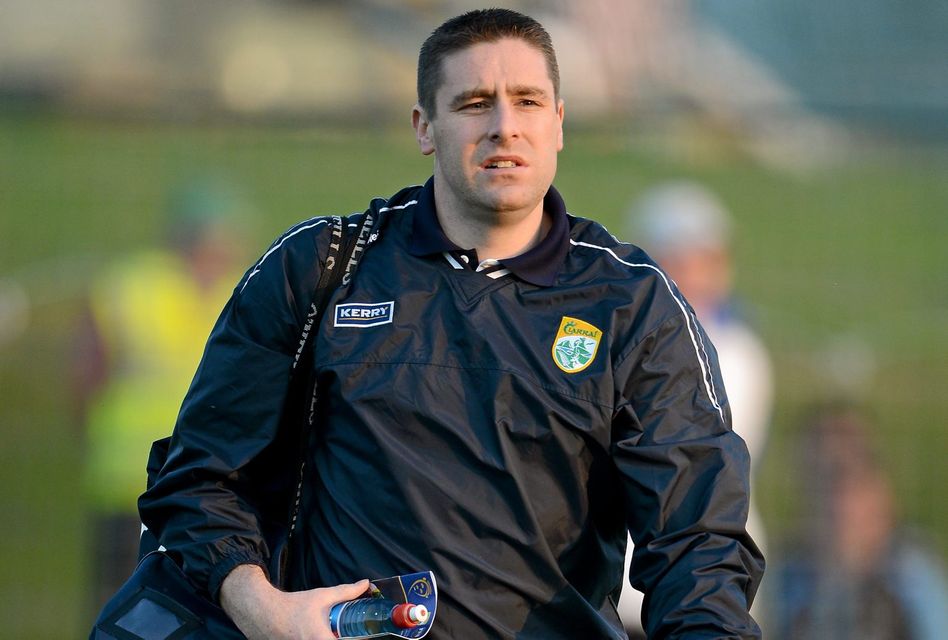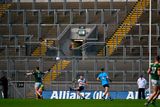Roy Curtis: Darragh Ó Sé reveals the sleeveen culture of modern Gaelic football
Diarmuid Connolly high-fives team-mate Bernard Brogan (L) after scoring Dublin’s first goal past Longford goalkeeper Paddy McCollum on Sunday SPORTSFILE
So it seems the narrative has advanced among Dublin’s foes: From splitting up the county to breaking its star player – Diarmuid Connolly – in two.
If Colm O’Rourke’s relentless drum-banging about dividing the Dubs into north and south merely threatened to perforate the eardrum, Darragh Ó Sé , it seems, is advocating altogether more brutal violence against Connolly.
Kerry’s totemic midfielder last week presented the nation with the Machiavellian masterclass option of “pulling (Connolly’s) tail and seeing if he’ll hiss back at you”.
Here, from one of the greatest footballers the game has seen, was the mask slipping: An insight into the foul pathogen, the Ebola of anything-goes-cynicism, the Black Death of cowardly winding-up, the sleeveen culture that pervades modern football.
As he ponders “how to get at Connolly” Ó Sé tells a story about a defender rolling around on the ground with an opposing attacker and suggests that this is the only credible option, the logical, if diseased, pathway to snuff out Dublin’s talisman... “A bit of don’t-ask, don’t-tell stuff off the ball”, is what he recommends.
Read more
Read more:
Darragh Ó Sé is the new Kerry manager, for a day.
Read more:
Now, cards on the table: Darragh is a friend of mine; his weekly column is forever peppered with insight, humour and mischievous anecdotes.
But if there is an element of realpolitik about his means of silencing Connolly, it is also, as he remarks himself, “nothing to be proud about”.
Imagine the furore if the roles were reversed. If this was, say, Brian Mullins or Keith Barr advising the systematic, no-holds-barred targeting of Colm Cooper.
Outrage would – properly – crash like a tsunami against Dublin’s borders. The depiction would be of the wilful defiling of a Kingdom treasure, of Jackeen vandals covering the Ring of Kerry in crude spray-painted tidings.
Perhaps the most depressing line in Darragh’s thesis was this: “If you think a player has a weakness, you have a responsibility to find it”.
Taken to its logical, incendiary conclusion, this viewpoint amounts to a cheat’s charter, a legitimising of rule-book pulping, the decriminalising of thuggery, self-regulation that sets aside both the laws of the game and of common decency.
It amounts to handing the keys of the kingdom to the bully boy.
What if the “weakness” is the emotional turmoil of the recent death of a parent, is it an opponent’s “responsibility” to sledge the bereaved?
Such unconscionably base behaviour could never happen, you might think; except the allegation is it did, with a Donegal minor recently mocked over his father’s tragic passing.
This is a retreat to the simian depiction of Paddy in late 19th century Punch cartoons. Except here we can’t blame the big, bad Brits. These caveman caricatures are self-portraits.
Ultimately, this is the flaw with any end-justifies-the-means philosophy such as the one which deems it reasonable to set the pitbulls on Connolly.
It reduces football to a joyless, boorish, unsophisticated exercise in nihilism.
So many modern-day coaches like to present themselves as intellectual grandmasters, they affect a deep-thinking pose on the sideline – detached, superior minds pondering the big questions; Stephen Hawking in a bainisteoir’s bib.
Read more
Read more:
Read more:
Now, if we are to take Ó Sé’s words at face value – and Darragh was manager of the Kerry U-21s for the past couple of seasons – we are led to believe that the sum total of their tactical insight is to wave a caveman’s club at the opposition’s danger man.
The targeting of Connolly is justified in Darragh’s column on the basis that “there’s still a bit of a scamp in him”.
Here is an unsubtle reference to a back catalogue of younger day misdemeanours.
Connolly has endured difficulties on and off the field: Sendings-off against Donegal in the 2011 All-Ireland semi-final and against Wexford this weekend three years ago.
There was a high-profile and, you imagine, mortifying court case.
But his behaviour in the last three years has been exemplary, turning the other cheek to provocation while decorating the arena with brushstrokes of authentic genius.
Anybody who observed the imaginative, virtuoso beauty of his 2014 All-Ireland club final masterpiece or his leadership in defeat against Donegal last year will understand that here is a footballer who operates on a different rung, who dares to be different.
He is, as O’Se concedes, “beautifully balanced… a silky, two-footed half-forward… he has everything”.
To then justify an anything-goes means of decommissioning a weapon of such scorching beauty amounts to the kind of cultural vandalism that would permit a developer taking a wrecking ball to a listed building in pursuit of profit.
A thread of cheerless, haughty, unsmiling, group-think sobriety runs through modern-day football. The notion of the game as a source of fun, an escape from the everyday, something that might aesthetically inspire, sport as sport, is dismissed as hopelessly old-school.
The humourless philosophy finds best expression in those truly pathetic codes of conduct to which teams adhere, where to stay up after Coronation Street or to drink anything stronger than cranberry is to be deemed treacherous.
It is as if players are signing up for the Foreign Legion rather than a game of football.
Yet it seems no code of conduct finds fault with caveman brutality.
Rolling around the turf 100 yards from play, knocking seven shades of sh*te out of the opposition’s best player is deemed not only acceptable, but encouraged as taking one for the team.
It all begs the question: What have we become, how skewed is the narrative when taking a pint of stout gets a player a managerial red card under some nonsensical, self-righteous puritanical code, but taking an opponent’s head off and sipping a pint of his blood makes him best boy in the class?
Read more
Read more:
Read more:
















